Florence is one of Italy’s most beautiful cities. The birthplace of the Renaissance, it’s home to artistic masterpieces, architecture, and charming piazzas next to narrow streets.
Three days is enough time to see the top attractions, go wine tasting in the countryside, and visit hidden gems.
I spent five packed days in Florence, and here, I share great things to do and tips to optimize your itinerary. This post covers:
- 🗓️ 3-day optimized itinerary
- 📍 Florence map with key places
- 🌟 Top attractions & hidden gems
- 🚇 How to get around
- 🏠 Where to stay
🇮🇹 Planning A Trip to Italy: 12 Practical Things To Know
Lists By Lukiih is readers-supported. When you buy with my affiliate link, I may earn a small commission. Thanks!
Florence at a Glance
Before getting into the itinerary, here’s some general information on Florence to help you plan your trip.
🎨 What Is Florence Known For?
Florence, or “Firenze” in Italian, is one of Italy’s most visited cities and is known for:
- Artistic masterpieces – It has some of the world’s most famous paintings, sculptures, and architectural wonders from artists like Leonardo da Vinci and Michelangelo. Florence is called an “open-air museum” for this reason.
- Historic centers – Florence’s historic center is a UNESCO World Heritage Site with a charming main square surrounded by narrow streets.
- Culinary prowess – Florence is in Tuscany, known for high-quality wine and local dishes like Florentine steak.
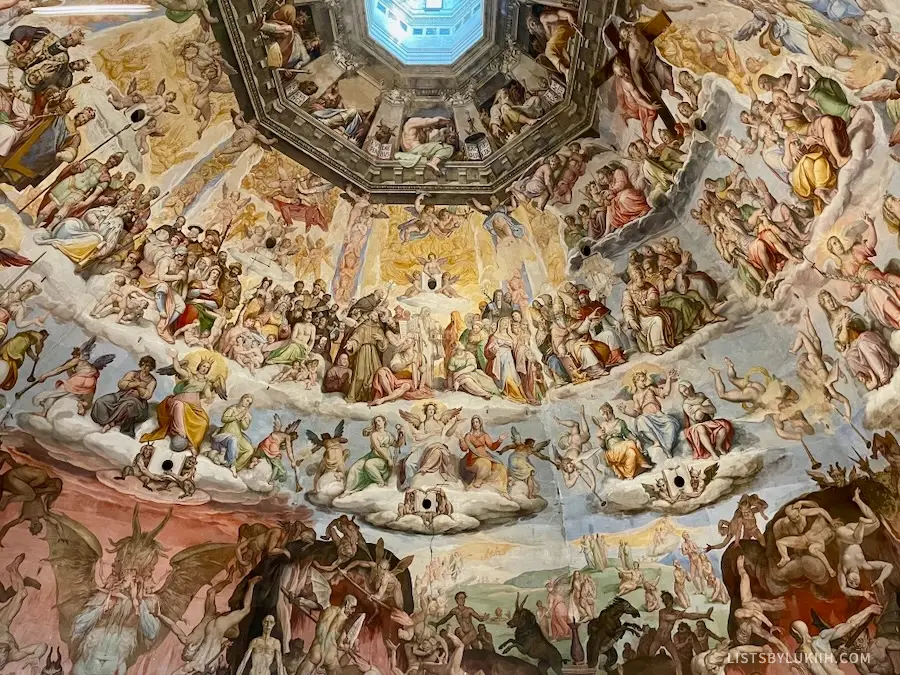
🗓️ How Long To Spend in Florence?
Two to three days in Florence is sufficient. This will give you enough time to see some of the city’s main attractions and take a day trip to the Tuscan countryside.
I was in Florence for five days, which was too long given my interests. The city is small, so I got tired of the same historic landscape. After three days, I was happy to go to Rome next for a more urban landscape.
See how to efficiently plan a trip to Italy.
📍 Where Is Florence Located?
Florence is the capital city of the Tuscany region in central Italy. Here’s how far the city is in relation to other major cities and landmarks:
| Landmark | Where is Florence? |
|---|---|
| Rome | 1 hr 30 mins north by train |
| Milan | 2 hrs southeast by train |
| Venice | 2 hrs 30 mins southwest by train |
| Leaning Tower of Pisa | 1 hr east by train |
| Cinque Terre | 3 hrs east by train |
☀️ Best Time To Visit Florence
The best time to visit Florence is during the spring or fall season.
- Spring (March to April) – The spring season has cooler temperatures ranging from 45 °F to 75 °F and fewer crowds. It’s a great time to visit the gardens and outdoor piazzas. I visited Florence in May and enjoyed the warm, but not hot, weather.
- Summer (June to August) – The summer months are the peak season, with temperatures ranging from 60 °F to 90 °F. Expect long lines and big crowds for Florence’s top attractions.
- Fall (September to October) – The fall has temperatures ranging from 50 °F to 80 °F, making it a great time to enjoy wine in the Tuscan countryside.
- Winter (November to February) – Winter is the low season with temperatures of 35 °F to 55 °F, so you’ll experience fewer crowds. It’s a good time to be indoors in all the art galleries and restaurants.
💰 Is Florence Expensive To Visit?
Being one of Italy’s major tourist cities, Florence is expensive to visit.
- Mid-range budget travelers can expect to spend about $160 a day in Florence.
- Budget travelers can expect to spend about $100 a day in Florence.
See my budget breakdown for my trip to Florence.
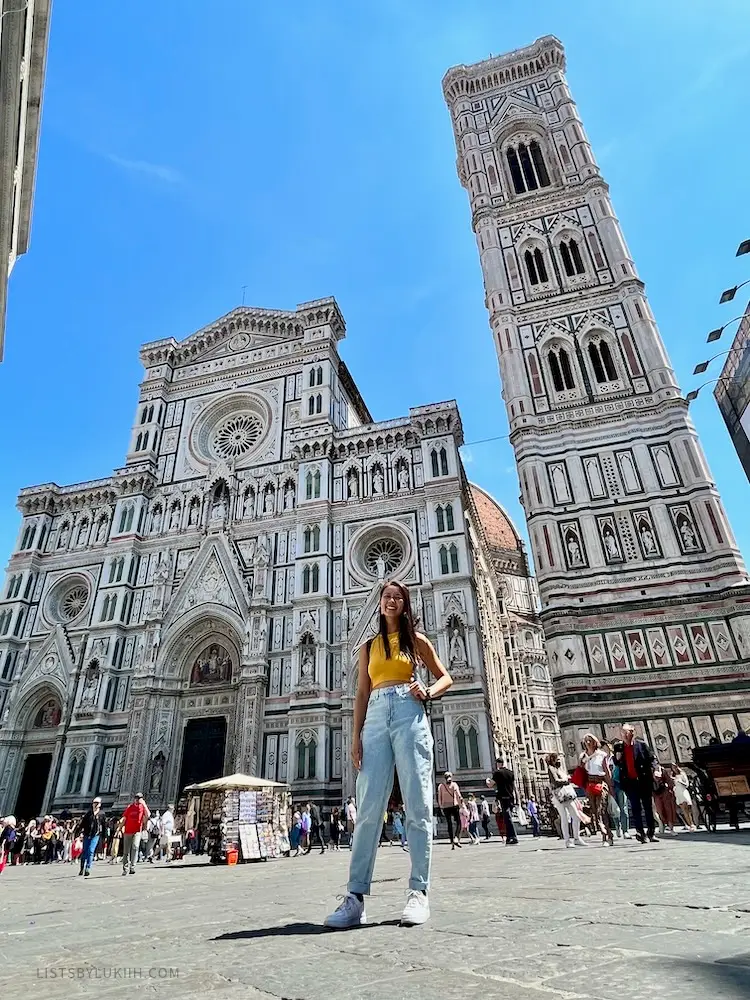
Getting Around Florence
Here’s how to get to Florence and get around once you’re there.
🚆 How To Get to Florence
The best way to get to Florence is by flying into Rome’s international airport, Leonardo da Vinci–Fiumicino Airport (FCO), and then taking the high-speed train an hour-and-a-half hour to Florence’s central train station, Santa Maria Novella.
Florence has its own international airport, Amerigo Vespucci Airport, but it’s much smaller than Rome’s.
If you’re coming from northern Italy, Florence is easily reached by train. It’s an hour south of Bologna, a little over an hour east of Pisa, and two hours south of Milan by train.
👟 How To Get Around Florence
Florence is not a small city, but it’s compact and well-connected, so the best ways to get around are by walking, taking public transport, biking, and calling a taxi.
- Walking – Florence is a pedestrian-friendly city, so many attractions are reachable on foot. I primarily got around the city by walking. It takes about 30 minutes to walk across the entire historic center.
- Bus and Tram – Florence doesn’t have a metro, but it does have a bus and tram system. The bus system is called ATAF, and it’s efficient and budget-friendly. A single ride costs less than $2 USD.
- Taxis – Florence has white-and-black taxis, but they’re fairly expensive, and you’ll need to find a taxi-designated area to ride in one. Hailing a taxi from a non-designated area is illegal).
- Uber – Florence has Uber, but they’re more like private drivers for hire and very expensive compared to taxis.
- Biking – Bikes are available in Florence outside the city center. If you bike, know that the city has specific road rules (e.g., you cannot bike the opposite way on one-way streets).
You can also rent a car in Florence, but it’s only recommended if you plan to explore the Tuscan countryside for most of your trip. Florence has winding, narrow streets, and many driving areas that are off-limits to tourists.
Florence Itinerary Map
This map has all the recommended places in the Florence travel itinerary below.
3-Day Itinerary for Florence
This Florence itinerary efficiently sequences attractions and activities the city is famous for.
I’ve also included suggested times for each activity based on my firsthand experience.
| Day 1 – David and the Duomo | ||
| 🚆 | Arrive in Florence | Morning |
| 🍕 | Lunch at Mercato Centrale | 12:30–2 pm |
| 🪨 | See Michelangelo’s David at Accademia Gallery | 2:15–3:30 pm |
| ⛪️ | Visit Florence’s Duomo | 4–6:30 pm |
| Day 2 – Uffizi and Wine Tasting | ||
| ☕️ | Start your day with a cup of espresso | Morning |
| 👟 | Walk through Piazza della Signoria | 10:30–11 am |
| 🖼️ | Visit the world-famous Uffizi Gallery | 11 am–12:30 pm |
| 🥪 | Lunch at All’Antico Vinaio | 12:30–1:30 pm |
| 🍷 | Go on a Tuscan wine-tasting tour | 2–7 pm |
| 🥩 | Try a Florentine steak for dinner | 8–9:30 pm |
| Day 3 – Oltrarno | ||
| 🛍️ | Window shop on Ponte Vecchio | 12–12:45 pm |
| 🍝 | Take a pasta-making class | 1–3:30 pm |
| 🪴 | See Boboli Gardens and/or Pitti Palace | 3:45–5 pm |
| 🌹 | Walk through the Rose Garden | 5:30–6 pm |
| ☀️ | Visit Piazzale Michelangelo for sunset | 6–7 pm |
🗓️ With Less Time: What To Skip in Florence
If you have less than three full days in Florence or want more downtime, here’s how to modify the itinerary:
- Skip Boboli Gardens and Pitti Palace – I found these to be Florence’s most underwhelming major attractions. I enjoyed the less well-known Rose Garden more.
- Skip the pasta-making class – A pasta-making class is a great option if you want more activities in Florence, but if you want to maximize seeing historical attractions, skip it.
- Skip Uffizi or Accademia Gallery – Florence is known for its art, but if you’re not a history or art lover, you can skip visiting the famous Uffizi Gallery or Michelangelo’s David at the Accademia Gallery.
🗓️ With More Time: What To Add to a Florence Trip
If you have extra time or days in Florence, consider adding these things to the itinerary:
- Take a day trip – The famous Tower of Pisa is an hour east of Florence. Siena, a medieval city, is an hour and a half south of Florence.
This highly-rated day trip tour from Florence visits both Pisa and Siena and provides transportation, which will get you to both locations faster than the train.
- Walk a bit further east of Florence’s historic center – On the east side, you’ll be able to visit the Basilica di Santa Croce, a significant church in Florence; AquaFlor, an ornate perfume store; and Vivoli, a highly-rated gelato shop.
- Explore the west area of the historic center – On the west side, you can visit the Santa Maria Novella Church, a basilica in a main square with a small garden, and Officina Profumo, an extremely fancy perfume shop that’s fun to browse.
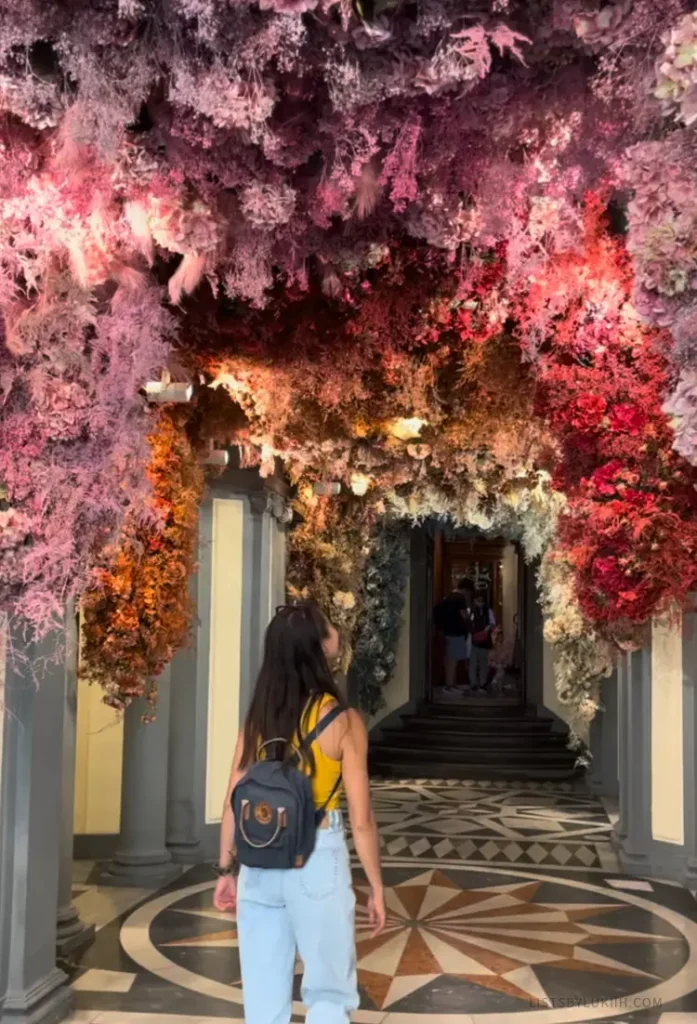
12 Great Things To Do in Florence
Having spent five packed days in Florence, I share my recommendations and honest opinions on the top attractions and activities below, listed in rough order of priority.
All prices mentioned here are in USD 💵 .
1. Catch the Sunset at Piazzale Michelangelo
🤔 Why: Piazzale Michelangelo is a large square on a hill that offers spectacular views of Florence. Unlike the view from Brunelleschi’s Dome, the Duomo appears as part of the skyline from here.
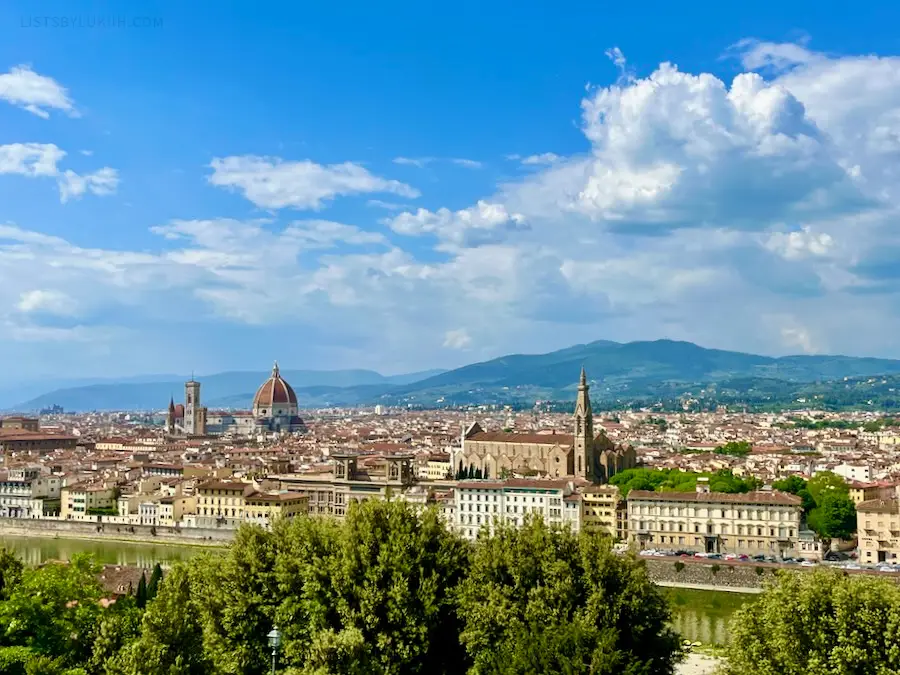
The hill to the plaza is steep, so be prepared. The viewpoint and stairs of Piazzale Michelangelo are popular sunset spots, so you need to get there 30 to 45 minutes beforehand to grab a great spot.
💰 Admission Fee: Free
⏰ Suggested Duration: 20 to 60 minutes
🍀 Lukiih’s Take: I visited Piazzale Michelangelo twice at two different points of the day and agree that it gives you the best view of Florence because it includes the iconic Duomo.
2. View Masterpieces in the Uffizi Gallery
🤔 Why: The Uffizi Gallery, or “Galleria degli Uffizi” in Italian, is one of the most renowned art museums in the world. It features artwork by Leonardo da Vinci, Michelangelo, Botticelli, Caravaggio, and Rembrandt.
Botticelli’s The Birth of Venus, one of the most recognizable works of Renaissance art, is on the second floor of the Uffizi Gallery.
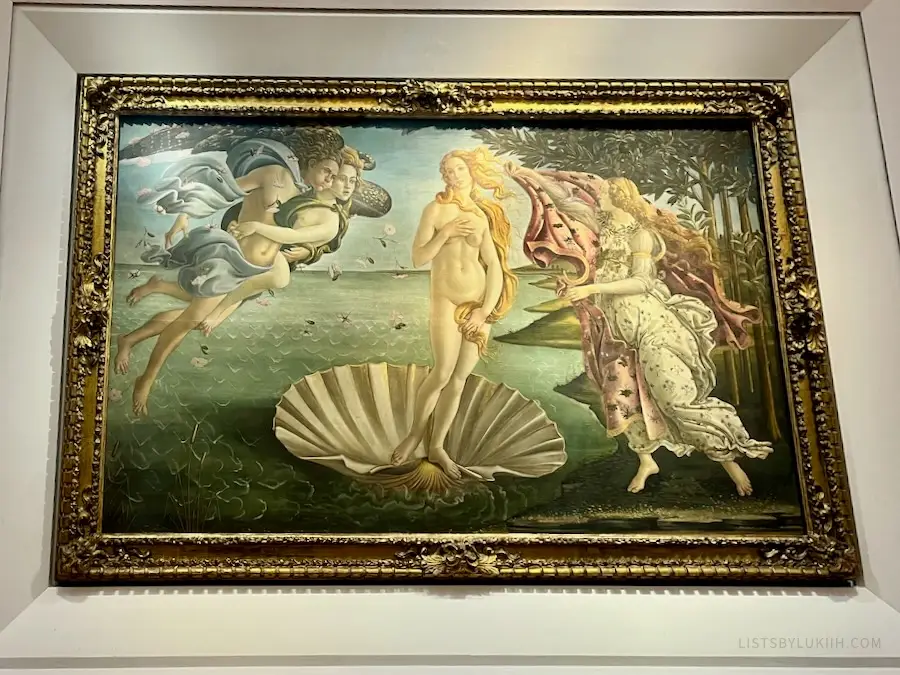
💰 Admission Fee: Uffizi tickets start at €12 (roughly $13).
This well-reviewed Uffizi Gallery guided tour includes the fast-track entrance ticket and allows you to learn about the art more intimately.
⏰ Suggested Duration: 2 to 3 hours
🍀 Lukiih’s Take: Seeing some of art history’s most famous pieces in the Uffizi Gallery in person was remarkable. The area outside the gallery is also great to walk through, as several street artists sell their work there as souvenirs.
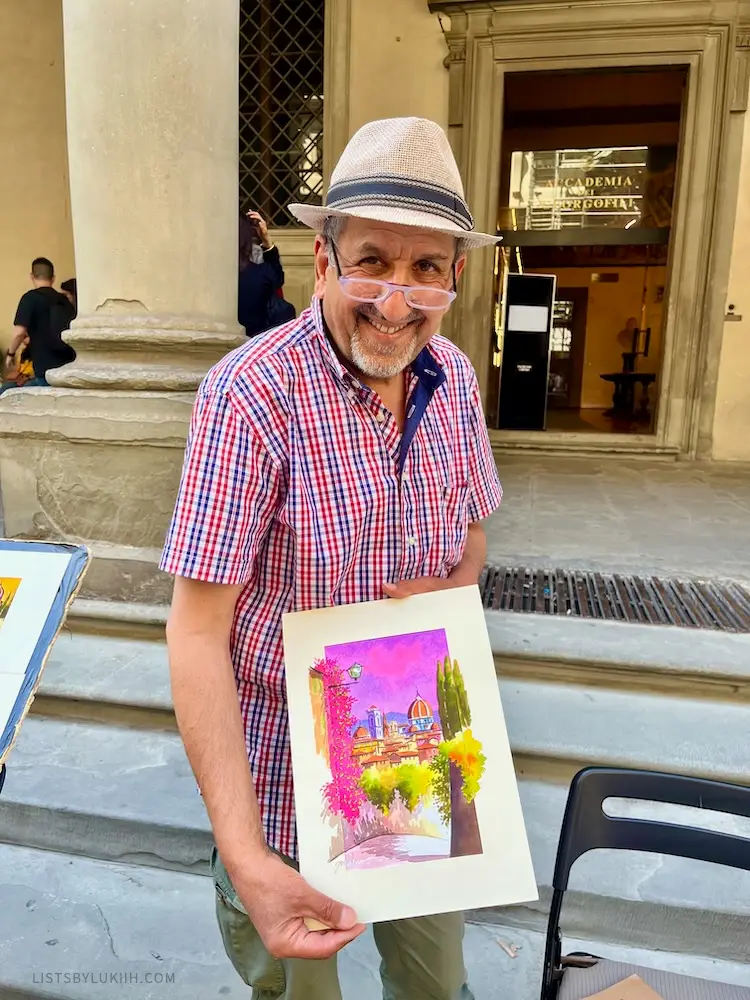
3. Taste Tuscan Wine in the Countryside
🤔 Why: Tuscany is famous for its wine-making excellence. Florence’s proximity to it makes it the perfect place to access the countryside. Many wine-tasting tours will also include Tuscan food like bruschetta and fresh cheese.
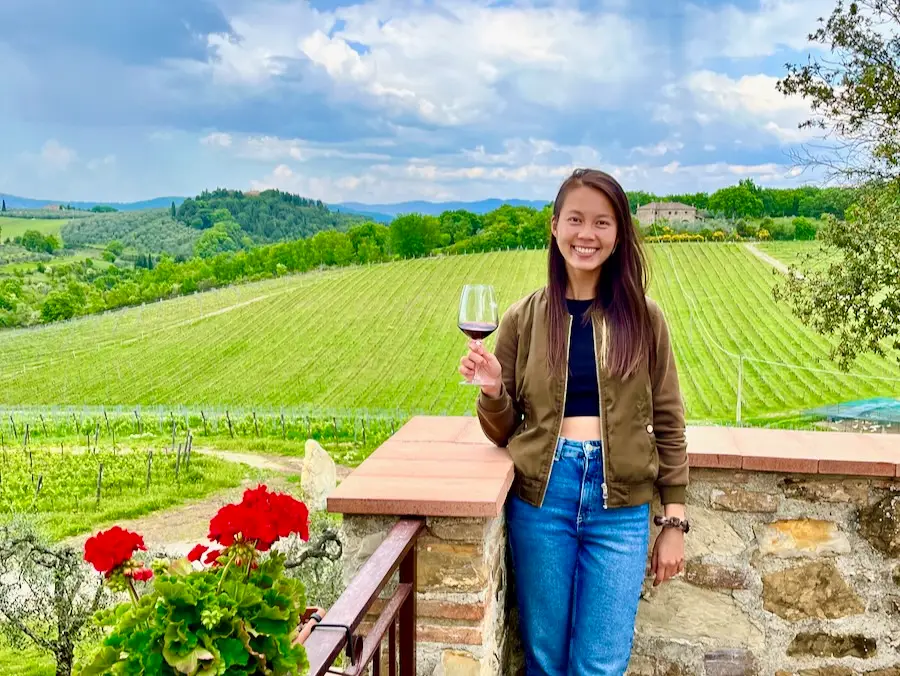
🚌 Getting There: You can access the Tuscan countryside through an organized tour or by renting a car (which is only worthwhile if you plan to stay multiple days in Tuscany). I went on this small-group wine-tasting tour that was well-run, tasty, and informative.
An alternative tour is to bike through the Tuscan wine country. If I were to take a second winery tour in Florence, biking would be my preferred method of transportation.
💰 Expected Cost: $30 to $200, depending on the tour length and whether they provide transportation to the Tuscany countryside.
⏰ Suggested Duration: Tours are typically 2 to 5 hours long.
🍀 Lukiih’s Take: My Florence wine-tasting tour at two Tuscany wineries significantly upgraded my wine knowledge and made me appreciate Chianti Classico wine.
4. Climb the Dome at Piazza del Duomo
🤔 Why: Piazza del Duomo is the heart of Florence and home to the iconic Duomo, the Cathedral of Santa Maria del Fiore. The main square is also a bustling center lined with cafes, restaurants, and artists.
✨ Great Things To Do: Piazza del Duomo has a few key attractions:
- Florence’s Cathedral (Duomo di Firenze) – This is Florence’s most famous attraction and one of Italy’s largest churches. You can walk 463 steps up Brunelleschi’s Dome to get one of the best views of Florence.
Due to limited space, tickets to Brunelleschi’s Dome must be purchased through the official website or a guided tour before visiting.
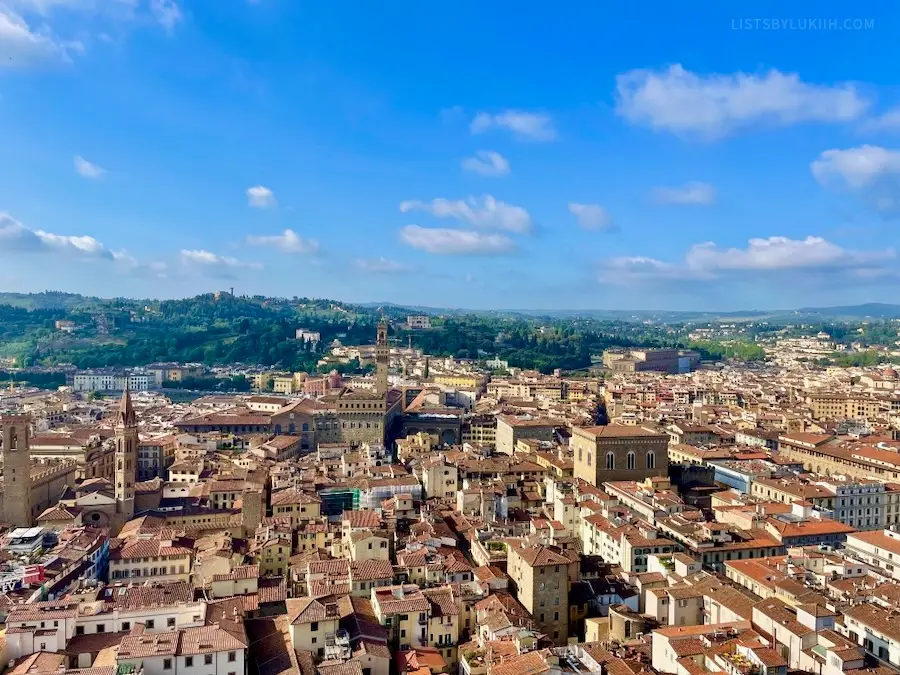
- Baptistery of St. John – A separate building connected to the Duomo, Baptistery of St. John has a unique and intricate exterior. Its most famous feature is the “Gates of Paradise” doors by Lorenzo Ghiberti, an Early Renaissance artist.
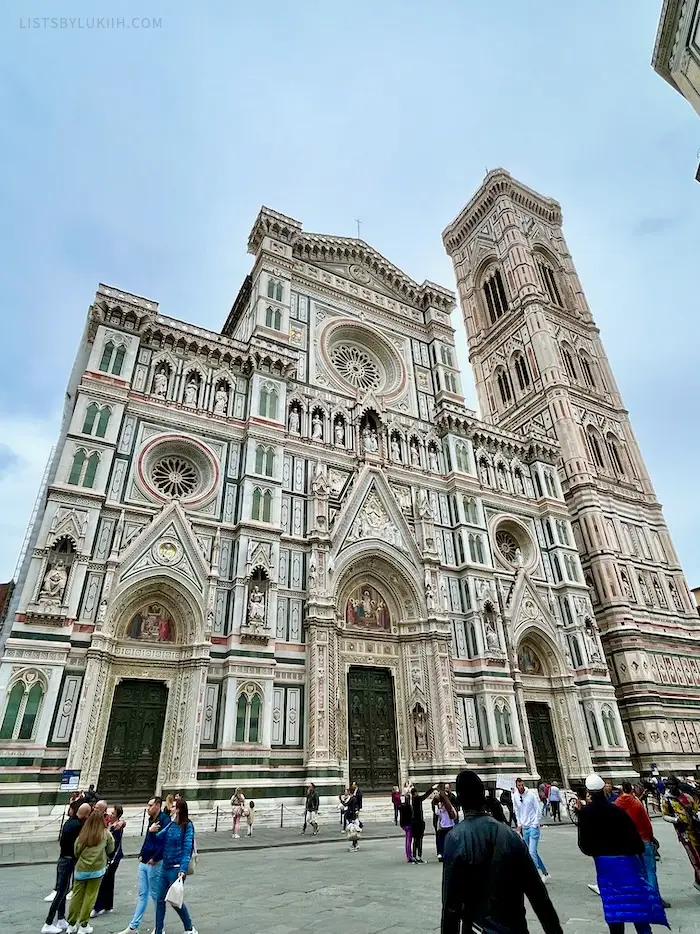
- Giotto’s Bell Tower – Also called Giotto’s Campanile, this is a freestanding bell tower renowned for its Italian Gothic design. You’ll see the bell tower from above when walking up the dome.
💰 Admission Fee: The Brunelleschis Pass, the required pass for the dome climb, costs €30 (roughly $32). A well-rated guided tour of the Florence cathedral, including the dome climb, is roughly $100.
⏰ Suggested Duration: 1 hour for the dome climb
🍀 Lukiih’s Take: Approaching Florence’s giant Duomo from a narrow street is one of the most surreal things I’ve seen, and you’ll know what I mean once you’ve experienced it. The dome climb is relatively easy if you’re in decent physical shape, and the panoramic views at the top are stunning (and different from the view you get at Piazzale Michelangelo later in the itinerary).
5. See David at Accademia Gallery
🤔 Why: The Accademia Gallery, or “Galleria dell’Accademia” in Italian, hosts some of the world’s most famous works of art, including Michelangelo’s David.
If you’re following this itinerary and walking to the Accademia Gallery from Central Market, you can make a quick stop at the Basilica di San Lorenzo, one of the oldest churches in Florence, dating back to Roman times.
💰 Admission Fee: Gallery tickets start at €13 (roughly $14).
Expect long lines (anywhere from 20 to over 45 minutes, depending on the season) to see Michelangelo’s David. You can skip the line by booking a highly-rated Accademia Gallery guided tour with a timed entry.
⏰ Suggested Duration: 60 to 90 minutes
🍀 Lukiih’s Take: I skipped seeing David as I chose to spend more time at the Ufizzi gallery and other places, but history buffs and art lovers should not miss it.
6. Learn the Secrets of Pasta-Making
🤔 Why: Florence is one of the best places in Italy to take a pasta-making class. While it’s not the food capital of Italy (Bologna is), you can learn to make Tuscan pasta specialties such as pappardelle and ravioli.

💰 Expected Cost: Classes start at $50.
I took this well-rated pasta-making class in Florence, and I highly recommend it.
⏰ Suggested Duration: 3 to 4 hours
🍀 Lukiih’s Take: My Florence pasta-making class was one of the most informative cooking classes. Many cooking classes around the world are more experience-based, where it’s difficult to replicate the meal (due to an ingredient or complexity constraint), but this class taught some solid basics about making pasta.
7. Walk Through Piazza della Signoria
🤔 Why: Piazza della Signoria is another well-known historic square in Florence that features notable attractions, including:
- Palazzo Vecchio – Translating to “Old Palace,” this historic building was built for the government of the Republic of Florence. It was also a residence for the Medici family, an extremely influential ruling family in Florence (e.g., they commissioned David).
- Loggia dei Lanzi – A historical landmark, Loggia dei Lanzi is an open-air sculpture gallery. Its most famous sculptures are Perseus with the Head of Medusa and The Rape of the Sabine Women.
Five minutes northwest is a smaller piazza called Piazza della Repubblica, a square surrounded by historic cafes and hotels. Three minutes west of the piazza is Fontana del Porcellino, a pig sculpture where it’s believed that rubbing its nose brings good luck.
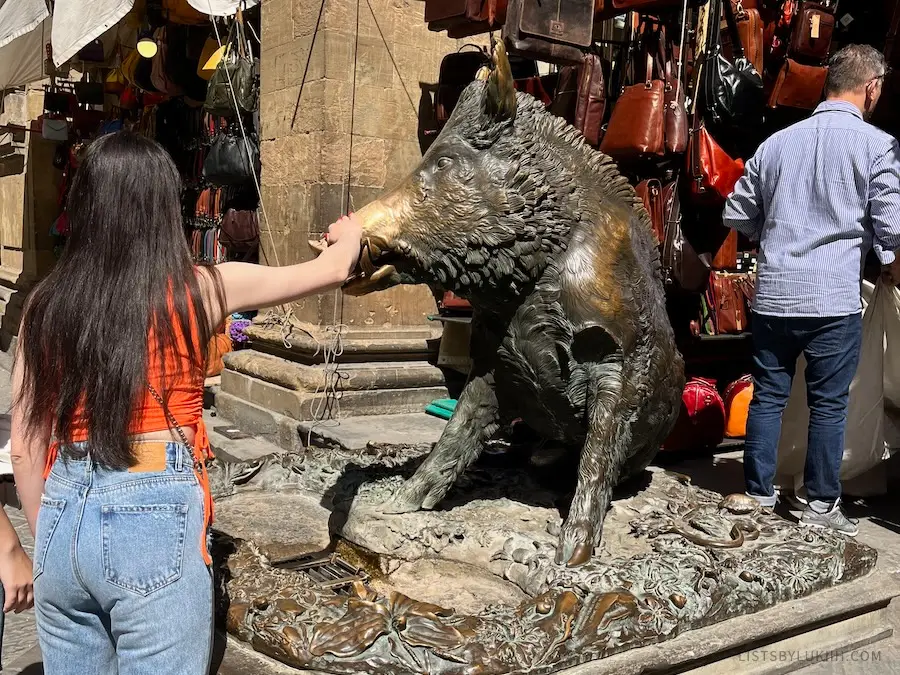
💰 Admission Fee: Palace tickets start at €10 (roughly $11). The piazza is free.
⏰ Suggested Duration: 15 to 45 minutes walking through the square
🍀 Lukiih’s Take: The attraction I enjoyed most in Piazza della Signoria was the open-air sculpture gallery. Seeing some famous sculptures I’ve learned about in art history class in real life was very cool (they were much bigger than I expected). I also tried to rub the pig sculpture’s nose, but there was a long line when I got there, so I skipped it.
8. Grab a Sandwich at All’Atico Vinaio
🤔 Why: One of my tastiest discoveries in Florence was All’Antico Vinaio, an extremely popular sandwich shop with no indoor seating. People buy sandwiches and sit down near the pedestrian-only sidewalks to eat them.
The All’Antico Vinaio line is exceptionally long, but it moves fast.
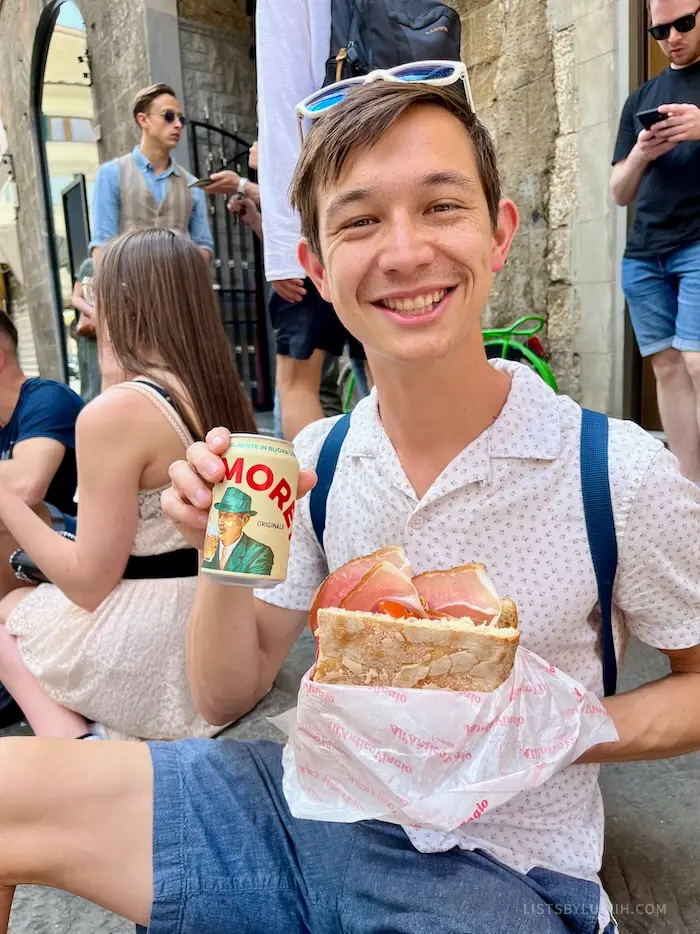
💰 Expected Cost: A sandwich costs €7 to €11 (roughly $8 to $12).
🍀 Lukiih’s Take: I highly recommend stopping at All’Antico Vinaio for lunch before heading on to a wine-tasting tour. The sandwich with fresh salami and cheese was one of my favorite things I ate in Italy.
9. Admire the Views at Giardino delle Rose
🤔 Why: The Giardino delle Rose is a beautiful garden filled with over 400 varieties of roses with different colors. Part of the garden is on a hill, giving you a panoramic view of Florence. This garden is a hidden gem and not considered a big attraction.
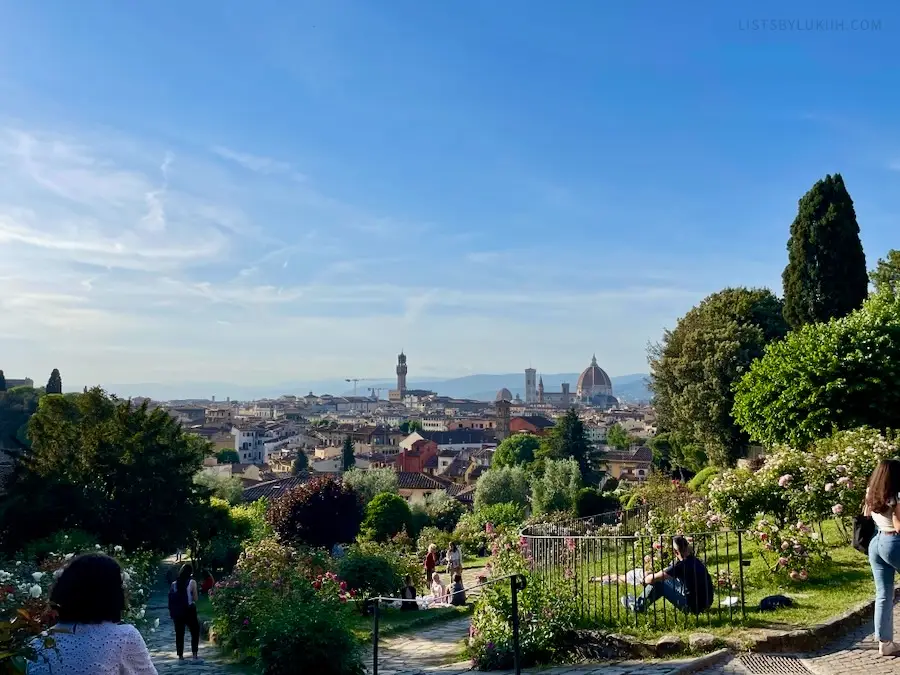
💰 Admission Fee: Free
⏰ Suggested Duration: 30 to 45 minutes
🍀 Lukiih’s Take: I enjoyed the rose garden much more than the famous Boboli Gardens. Prioritize the Boboli Gardens if you like more history and looking at well-manicured hedges, and the Rose Garden if you prefer to see flowers.
10. Satisfy Your Italian Food Cravings at Mercato Centrale
🤔 Why: Mercato Centrale is a lively, bustling market offering local specialties and Italian delicacies (e.g., cheese, cured meats, truffles). The food court will allow you to satisfy any Italian food craving.
The San Lorenzo Market is divided into two sections: Central Market and the outdoor market. The latter sells a wide variety of Italian leather goods (e.g., bags and shoes), jewelry, and souvenirs.

Mercato Centrale gets crowded during peak lunch (12:30–2 pm) and dinner hours (8–10 pm), so eat earlier or later to avoid the rush.
💰 Expected Cost: Similar to a typical Italian restaurant (roughly $12 to $20 for a plate of pasta).
⏰ Suggested Duration: 1 to 2 hours
🍀 Lukiih’s Take: You can get more cost-efficient meals elsewhere, but it’s nice to have a wide variety of authentic Italian food to choose from upon arrival, which is why Mercato Centrale is a great place to kick off your Florence trip.
11. Cross Ponte Vecchio
🤔 Why: Ponte Vecchio, which translates to “Old Bridge,” is an iconic bridge over the Arno River that runs through Florence. The bridge not only has historical significance, but it’s also a busy commercial hub lined with shops selling jewelry, luxury goods, and souvenirs.
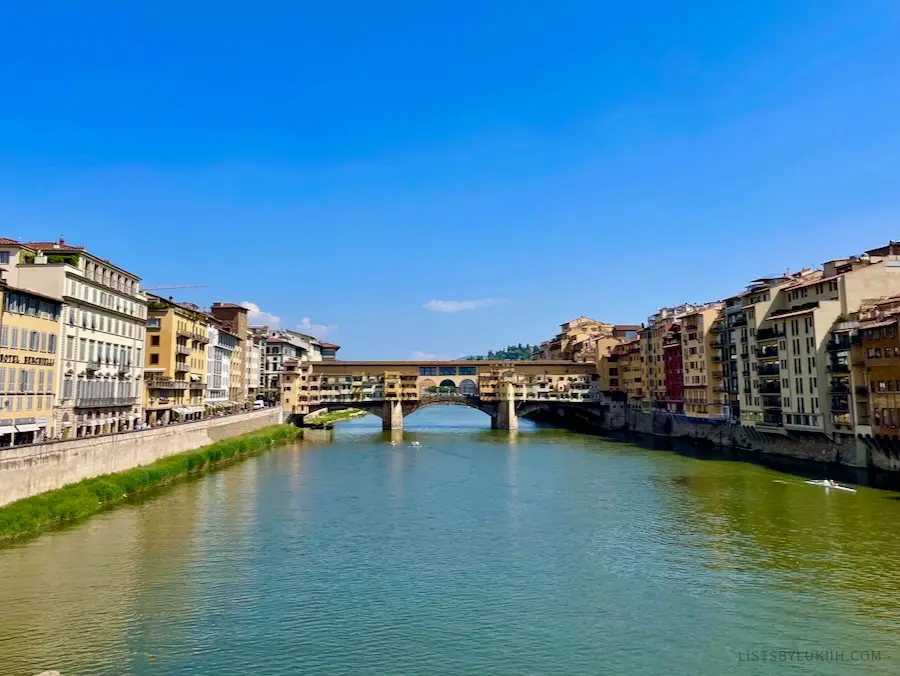
💰 Admission Fee: Free (shops on the bridge have medium to high price tags).
⏰ Suggested Duration: 5 to 45 minutes
🍀 Lukiih’s Take: I found Ponte Vecchio to be too touristy and crowded for my preference when I visited, but it was memorable to press my way through all the businesses and shops. Ponte alle Grazie is a much quieter local bridge to walk to the other side of the river.
12. Eat Florentine Steak
🤔 Why: One of Florence’s most famous foods is the Florentine steak, also called “Bistecca alla Fiorentina.” This is a renowned, traditional Tuscan high-quality, thick-cut steak seasoned with salt and served rare or medium-rare.
Most restaurants serving Florentine steak are fancier and will require advanced reservations.
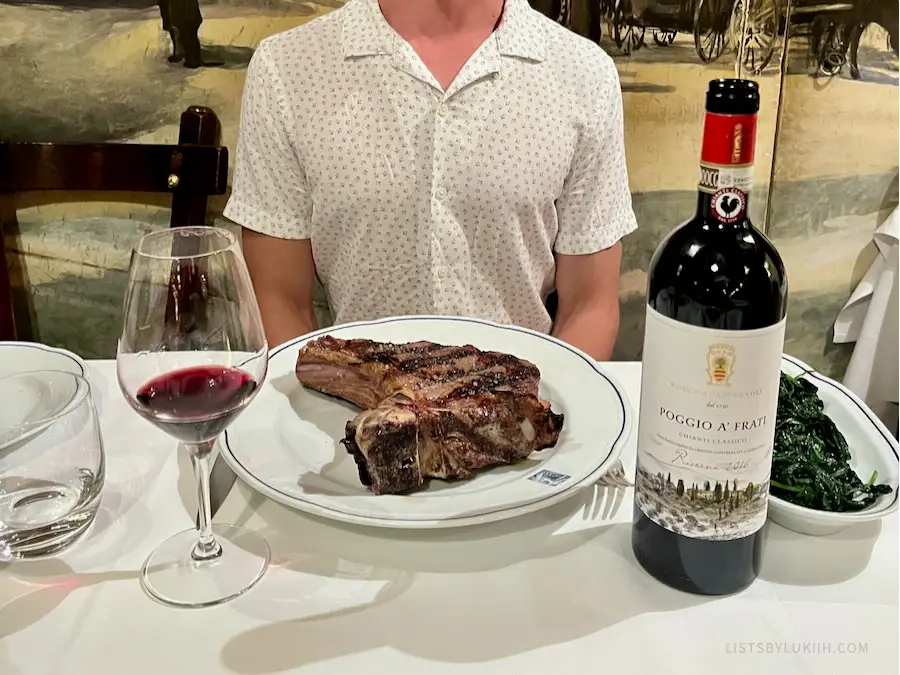
🍀 Lukiih’s Take: I tried the Florentine steak at Buca Lapi and recommend the experience to meat lovers. If you’re a vegetarian, you can try other Florentine foods such as ribollita (a rustic vegetable soup), pappa al pomodoro (another flavorful vegetable soup), or tagliatelle al Tartufo (a pasta served with a truffle sauce).
13. Visit the Boboli Gardens and Pitti Palace
🤔 Why: The Boboli Garden is a masterpiece of landscape architecture and represents an early example of the Italian formal garden style. The entrance to the gardens is the Pitti Palace, or “Palazzo Pitti,” where you can see the highly decorated royal apartments.
💰 Admission Fee: Garden tickets start at €6 (roughly $6.50)
⏰ Suggested Duration: 1 to 3 hours
🍀 Lukiih’s Take: Truthfully, the Boboli Gardens was the most underwhelming attraction I saw in Florence, partially because I didn’t understand what the early Italian formal garden style meant. Expect to see a lot of sculptures and well-kept hedges, but not many flowers.
Since I was underwhelmed by the Boboli Gardens, I left early. Instead, I enjoyed a nice glass of wine and a plate of prosciutto at a nearby wine bar, Enoteca Pitti Gola e Cantina, which was a great experience.
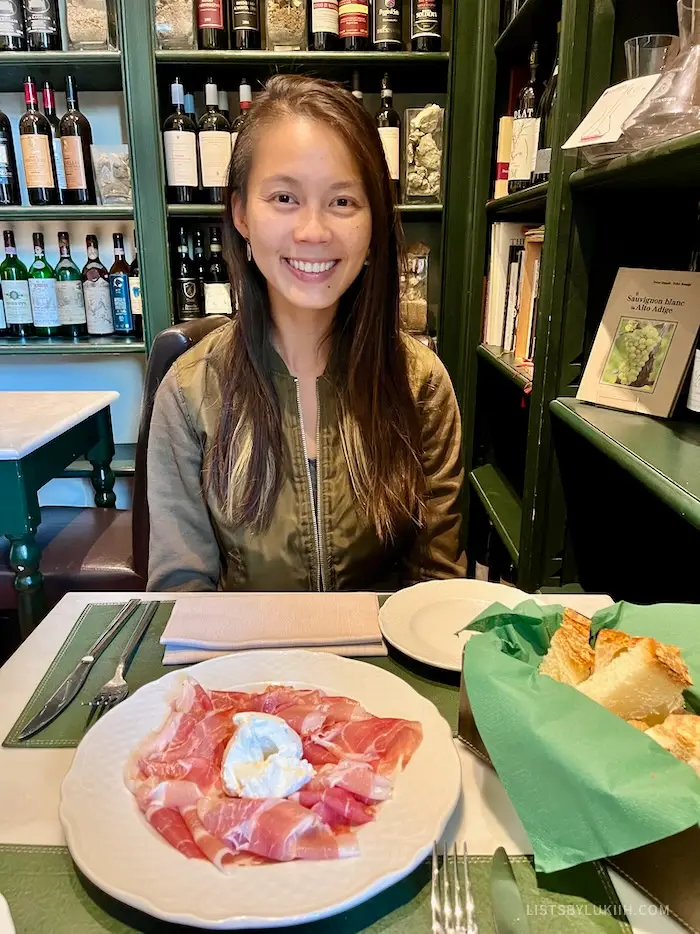
Where To Stay in Florence
Florence has several neighborhoods you can stay in. Here are some of the most popular areas to find accommodations:
Option 1: Historic Center
📍 Location: The historic center of Florence is where the Duomo is located, and it’s a lively area.
⭐️ Pros and Cons: If you stay in the historic center, you’ll have access to many great shops and restaurants, but it will be busy from early morning to late at night. It’s also a very touristy area.
💰 Accommodation Cost: Hotels in the historic center are typically more expensive. Finding anything under $130 a night during the peak season will be challenging. Hotel De Lanzi has a great view of the Duomo, and it’s one of the cheaper hotels in the area.
Option 2: Santa Maria Novella
📍 Location: Conveniently located near Florence’s main train station, the Santa Maria Novella area is walking distance from the historic center.
⭐️ Pros and Cons: I stayed at the simple Hotel Montreal in Santa Maria Novella. It’s a great value for its location and suitable for visitors like me who don’t plan to stay inside for most of their trip.
💰 Accommodation Cost: I paid $65 per person per night at Hotel Montreal when I visited during the spring season.
A nearby, non-Italian restaurant I ate at several times was SIG.RISO, which serves solid Chinese food at affordable prices. I went there each time I got tired of Italian food after traveling in the country for over two weeks.
Option 3: Oltrarno
📍 Location: Oltrarno is the area across the Arno River where the Boboli Gardens is located.
⭐️ Pros and Cons: Oltrarno is a quieter, more residential area to stay in, but it is farther away from some of Florence’s major attractions, like the Duomo.
💰 Accommodation Cost: Oltrarno’s prices are pretty high, with most hotels near the Arno River being higher than $200 per night.
Option 4: San Lorenzo
📍 Located: San Lorenzo is near the Central Market on the north side of the historic center
⭐️ Pros/Cons: San Lorenzo has more street markets and an authentic, local atmosphere. It’s still within walking distance of the Duomo complex but will be a hike to any major attractions near or across the Arno River (e.g., Uffizi Gallery, Piazzale Michelangelo).
💰 Accommodation Cost: The San Lorenzo area is generally more budget-friendly. You can find several hotels for less than $200 a night here.
Italy Trip Planner 2024
To make your travel preparation easier, download the trip planner below. It has destination-specific travel information, itinerary, map, and packing list.
My trip planners are built on Notion, which I use for all my travel planning. I genuinely love this tool and creating an account is free.
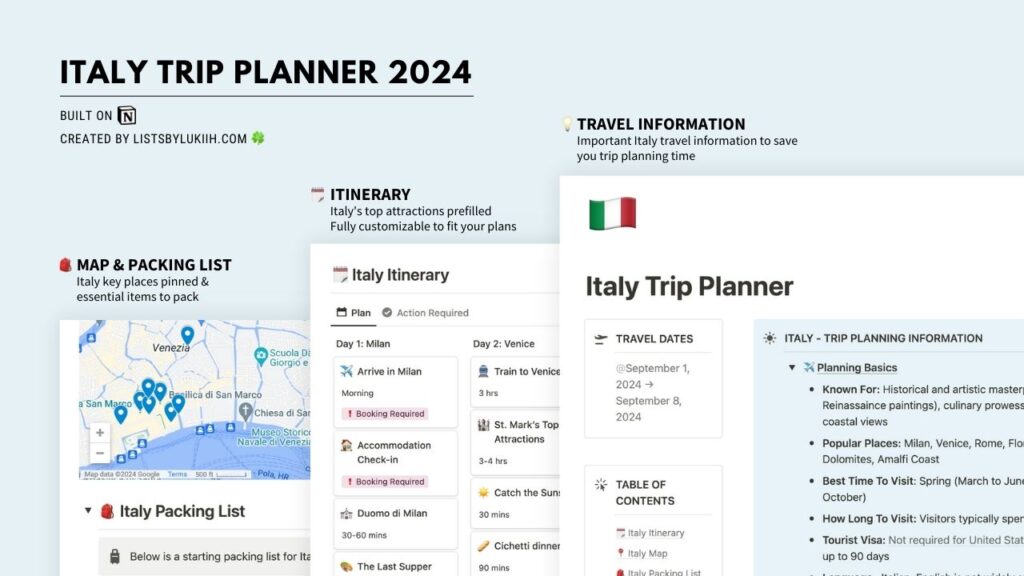
Italy Travel Guides
- 🇮🇹 Planning A Trip to Italy: 12 Practical Things To Know
- 🍝 7-10 Days in Northern Italy: 2 Efficient Itineraries
- 💰 My Italy Trip Cost: Budget Breakdown (2025)
- 🎭 Venice Day Trip: 8 Great Things To Do + 1-Day Itinerary
- 👨🎨 3 Amazing Days in Florence: Itinerary With Hidden Gems
- ⛰️ Hiking Cinque Terre: My Honest Review & Tips
- 🌷 Lake Como Day Trip: My Honest Review & Tips
- 🚣♂️ Gondola Ride in Venice: My Honest Review & Tips
- 🧀 Parma Day Trip (Italy): My Honest Review & Tips